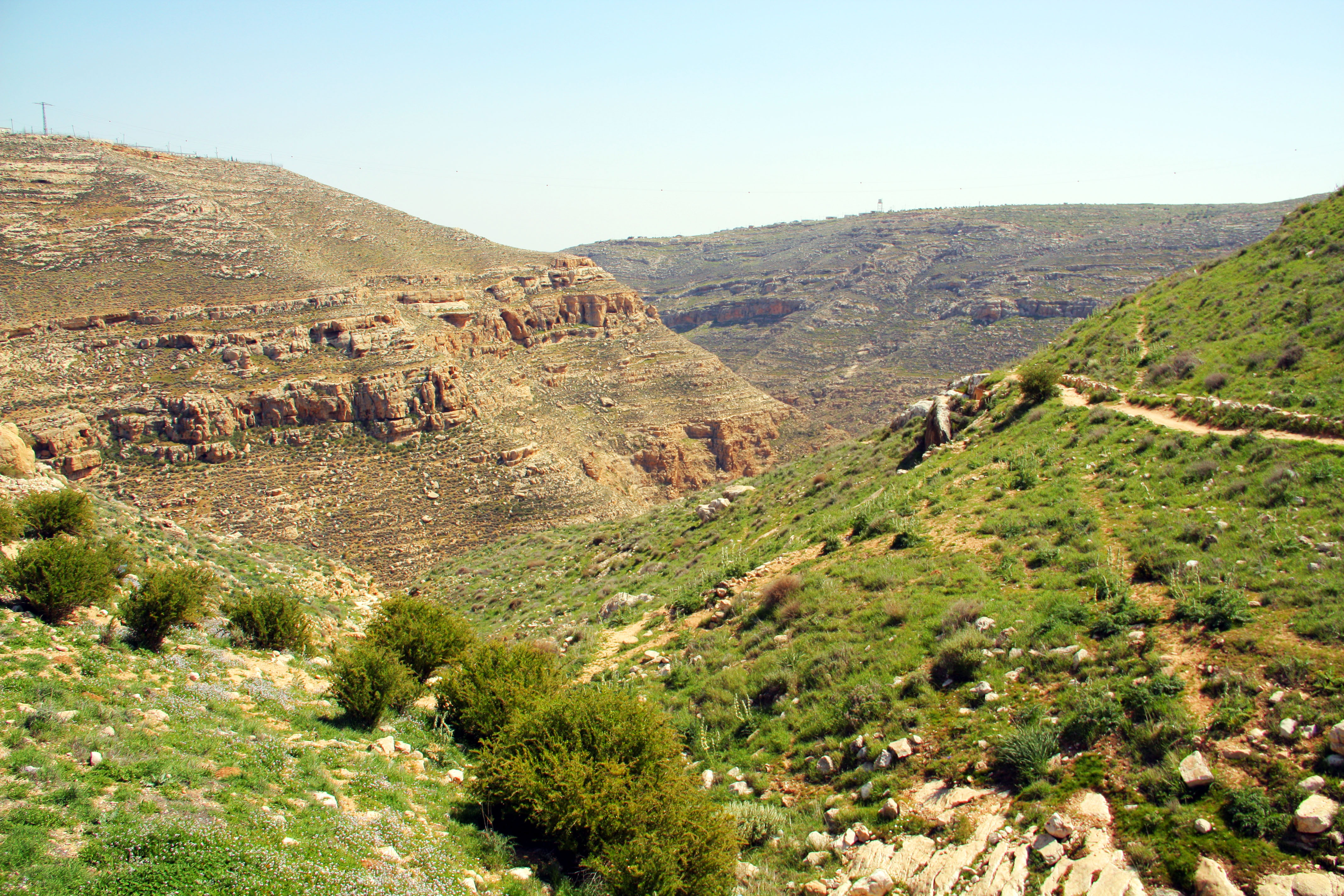Wadi Khureitun on:
[Wikipedia]
[Google]
[Amazon]
 Wadi Khureitun or Nahal Tekoa is a
Wadi Khureitun or Nahal Tekoa is a
 Wadi Khureitun or Nahal Tekoa is a
Wadi Khureitun or Nahal Tekoa is a wadi
Wadi ( ar, وَادِي, wādī), alternatively ''wād'' ( ar, وَاد), North African Arabic Oued, is the Arabic term traditionally referring to a valley. In some instances, it may refer to a wet (ephemeral) riverbed that contains water onl ...
in a deep ravine in the Judaean Desert
The Judaean Desert or Judean Desert ( he, מִדְבַּר יְהוּדָה, Midbar Yehuda}, both ''Desert of Judah'' or ''Judaean Desert''; ar, صحراء يهودا, Sahraa' Yahuda) is a desert in Palestine and Israel that lies east of Jerusa ...
in the West Bank
The West Bank ( ar, الضفة الغربية, translit=aḍ-Ḍiffah al-Ġarbiyyah; he, הגדה המערבית, translit=HaGadah HaMaʽaravit, also referred to by some Israelis as ) is a landlocked territory near the coast of the Mediter ...
, west of the Dead Sea
The Dead Sea ( he, יַם הַמֶּלַח, ''Yam hamMelaḥ''; ar, اَلْبَحْرُ الْمَيْتُ, ''Āl-Baḥrū l-Maytū''), also known by other names, is a salt lake bordered by Jordan to the east and Israel and the West Bank ...
, springing near Tekoa.
Name
The Hebrew name, Nahal Tekoa ("Tekoa Stream"), and theEnglish
English usually refers to:
* English language
* English people
English may also refer to:
Peoples, culture, and language
* ''English'', an adjective for something of, from, or related to England
** English national ide ...
name used in some Christian contexts, Tekoa Valley, is derived from the ancient Judahite town of Tekoa.
The Arabic name, Wadi Khureitun, comes from the early Christian hermit, Saint Chariton the Confessor
Chariton the Confessor (Greek: Χαρίτων; mid-3rd century, Iconium, Asia Minor – c. 350, Judaean desert) was a Christian saint. His remembrance day is September 28.
Life Sources
We know about his ''vita'' from the 6th-century "Life of Cha ...
, who founded his third lavra
A lavra or laura ( el, Λαύρα; Cyrillic: Ла́вра) is a type of monastery consisting of a cluster of cells or caves for hermits, with a church and sometimes a refectory at the center. It is erected within the Orthodox and other Eastern Chr ...
in this valley.
Description, history, archaeology
A hiking path on the west of the wadi passes a number ofprehistoric
Prehistory, also known as pre-literary history, is the period of human history between the use of the first stone tools by hominins 3.3 million years ago and the beginning of recorded history with the invention of writing systems. The use of ...
caves on its way south to the Chariton Monastery ruins.
The archaeological Stone Age
The Stone Age was a broad prehistoric period during which stone was widely used to make tools with an edge, a point, or a percussion surface. The period lasted for roughly 3.4 million years, and ended between 4,000 BC and 2,000 BC, with t ...
(Mesolithic
The Mesolithic (Greek: μέσος, ''mesos'' 'middle' + λίθος, ''lithos'' 'stone') or Middle Stone Age is the Old World archaeological period between the Upper Paleolithic and the Neolithic. The term Epipaleolithic is often used synonymous ...
and Neolithic
The Neolithic period, or New Stone Age, is an Old World archaeological period and the final division of the Stone Age. It saw the Neolithic Revolution, a wide-ranging set of developments that appear to have arisen independently in several parts ...
) site of El Khiam
El Khiam (الخیام) is an archaeological site near Wadi Khureitun in the Judaean Desert in the West Bank, on the shores of the Dead Sea.
Archaeological finds at El Khiam show nearly continuous habitation by groups of hunters since the Mesol ...
is located in this area.
Saint Chariton the Confessor (end of 3rd century-ca. 350) founded here the Lavra of Souka, later called the Old Lavra, and today popularly known as the Chariton Monastery.
Existing karst
Karst is a topography formed from the dissolution of soluble rocks such as limestone, dolomite, and gypsum. It is characterized by underground drainage systems with sinkholes and caves. It has also been documented for more weathering-resistant ro ...
ic caves from the chalk
Chalk is a soft, white, porous, sedimentary carbonate rock. It is a form of limestone composed of the mineral calcite and originally formed deep under the sea by the compression of microscopic plankton that had settled to the sea floor. Chalk ...
stone of the wadi were expanded and used as hermit abodes by monks from the lavras of Saint Chariton and of a later desert monk and saint, Euthymius the Great
Euthymius the Great (377 – 20 January 473) was an abbot in Palestine. He is venerated in both Roman Catholic and Eastern Orthodox Churches.
Euthymius' ''vita'' was written by Cyril of Skythopolis, who describes him as the founder of several ...
.
Modern Tekoa's former chief rabbi Menachem Froman
Rabbi Menachem Froman (also spelled ''Menahem'' and ''Fruman''; he, מנחם פרומן; 1 June 1945 – 4 March 2013) Note: Birth date is 1 Jan – 4 Mar 1945 based on 1) year known as 1945, 2) age known to be 68, 3) date of death kn ...
's son, Tzuri, lived in the desert canyon wadi behind the town, in a cave
A cave or cavern is a natural void in the ground, specifically a space large enough for a human to enter. Caves often form by the weathering of rock and often extend deep underground. The word ''cave'' can refer to smaller openings such as sea ...
.
References
{{DEFAULTSORT:Khureitun, Wadi Wadis of the West Bank Judaean Desert